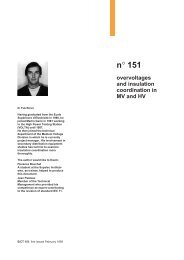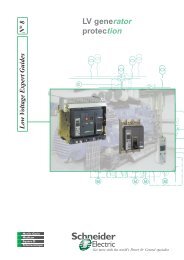Ground Fault Protection - engineering site - Schneider Electric
Ground Fault Protection - engineering site - Schneider Electric
Ground Fault Protection - engineering site - Schneider Electric
- No tags were found...
You also want an ePaper? Increase the reach of your titles
YUMPU automatically turns print PDFs into web optimized ePapers that Google loves.
5.3 Summary table5.3.1. Depending on the installation systemThe table below indicates the possible GFP choices depending on the system.Type of GFPInstallation supply endSingle-sourcee Multisource /Single-groundMultisource /MultigroundSub-distributionAll SystemsGFP combined CB GFP combined CB GFP combined CB GFP combined CB3P 4P 3P 4P 3P 4P 3P 4PSource <strong>Ground</strong> Return SGR v v b b (2) b v b (4)Residual Sensing RS v v b (1) b (2) b b (3) b (4) b v bZero Sequence (5) ZS v v v b b v b (4) v v v(1) allows for an extension (2 nd source) without any problems.(2) - if a neutral for each source is available, the RS type can be used- if a PE for each source is available, the SGR type can be used- in all cases, an SGR type can be used on the general PE (but with discriminationloss between sources).(3) allows for protection standardisation.(4) 3P is possible but the system is more complicated and there is neutral currentflow in the PE.(5) used for weak current values (200 A).Key:b required or highly recommended,v possible,b forbidden or strongly disrecommended.5.3.2. Advantages and disadvantages depending onthe type of GFPDifferent analyses, a comparative of different GFP types.Residual Sensingwith 4P circuit-breaker(CT on built in Neutral)with 3P circuit-breaker(CT on external Neutral)Source <strong>Ground</strong> ReturnAdvantagesb CT of each phase and neutral built-into the circuitbreaker(standard product)b Manufacturer Guaranteeb Assembled by the panel builder (can be factorytested)b Safe thanks to its own current supplyb Can be installed on incomers or outgoersb Assembled by the panel builder (can be factorytested)b Can be applied to different systems: a neutralcan be used “separately” from the circuit-breakerb Safe thanks to its own current supplyb Can be installed on incomers or outgoersb Can be applied to different systems: a PE conductorcan be used “separately” from the circuit-breakerb Safe thanks to its own current supplyb Can be added after installationDisadvantagesb Tolerance in measurements (only low sensitivity> 100 A)b Protects only the downstream of the circuit-breakerb Tolerance in measurements (only LS > 100 A)b Neutral current measurement cannot be forgottenb The CT is not built into the circuit-breaker =good positioning of the neutral’s CT (direction)b Protects only the downstream of the circuit-breakerb The CT is not built into the circuit-breakerb Requires access to the transformer(factory testing not possible)b Cannot be installed on sub-distributed outgoersZero Sequence b Can detect weak current values (< 50 A)b Uses autonomous relaysb Requires an auxiliary sourceb Difficult installation on large cross-sectionconductorsb Toroid saturation problem (solutions limited to 300 A)36

















